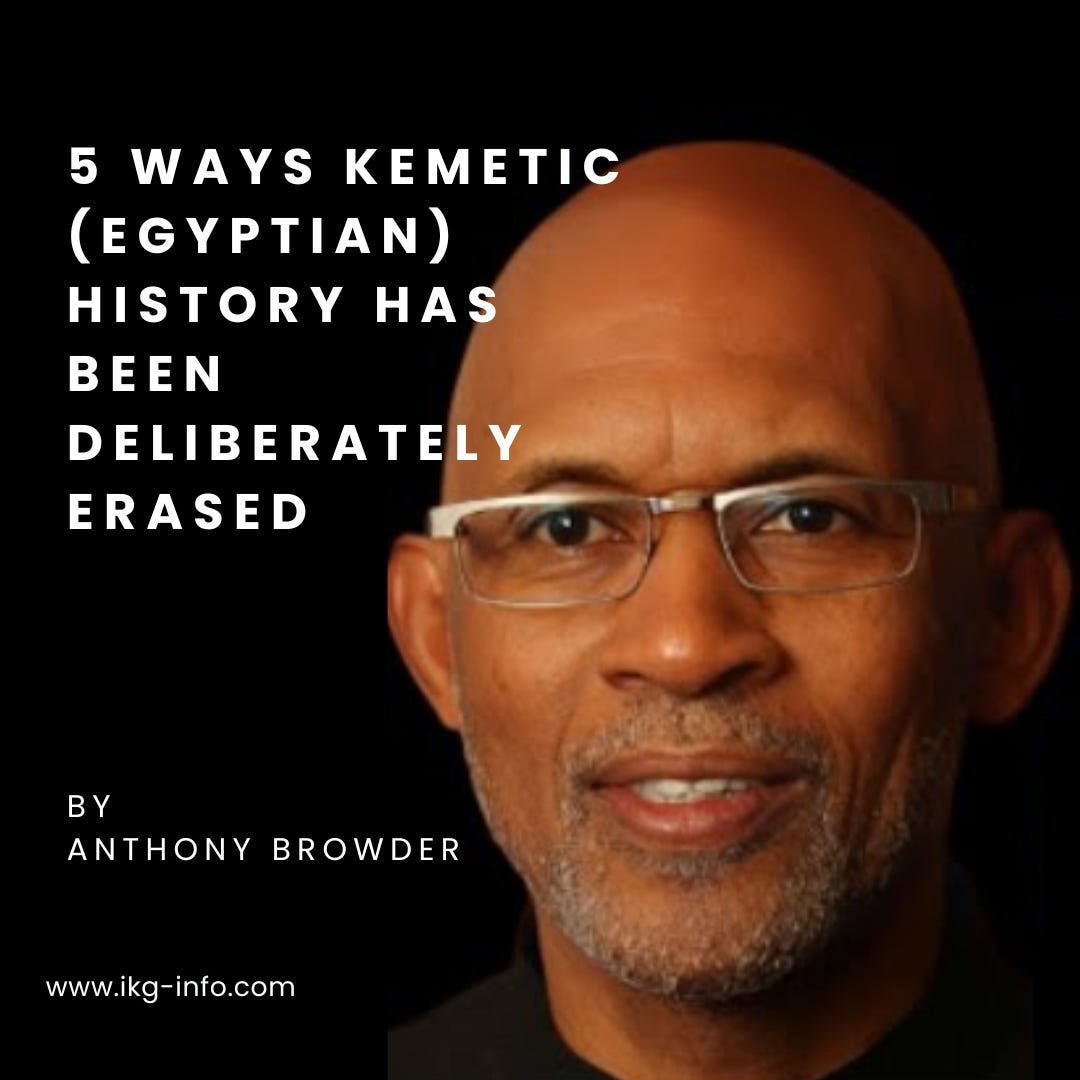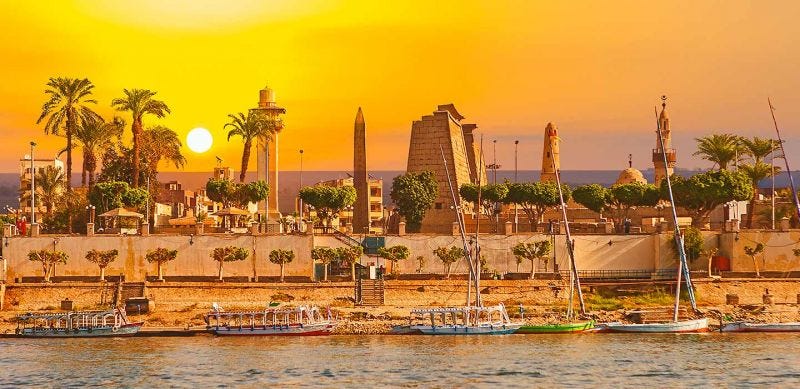5 Ways Kemetic (Egyptian) History Has Been Deliberately Erased
5 patterns of erasure you’ll never unsee
Anthony BrowderAug 20, 2025

The most dangerous lie isn't the one that contradicts truth—it's the one that erases it.
For thirty-eight years, I've watched people discover the magnificent temples of Waset and experience the same shock. Not just because of what they're seeing, but because of what they've never been taught.
This isn't an accident.
There's a pattern to how civilizations get erased from collective memory, and once you learn to spot it, you'll see it everywhere.
#1 The Name Change Pattern
Here's the first thing to look for:When the original name of a place disappears, ask why.
The Kemetic people called their greatest city "Waset"—meaning "The Scepter." This was the seat of government for the most powerful nation in ancient times. But notice what happened:
• Greeks renamed it "Thebes"
• Greeks also called it "the city of Zeus"—their supreme deity
• Arabs called it "L'Ouqsor"—meaning "The Palaces"
• Europeans changed "L'Ouqsor" to "Luxor"
• The word "luxury" itself comes from this African city
When conquerors are so impressed they name a place after their highest god, that tells you something about the original builders.
Every time someone talks about "luxury" today, they're unconsciously paying homage to ancient Kemet. But how many people know this?

#2 The Impossible Achievement Pattern
The second pattern reveals the deepest psychological defense against African genius:When achievements are too advanced to ignore, they get labeled "impossible" for their creators.
Here's how this works in practice.
At Waset, English astronomer Sir Norman Lockyer spent years studying the temple orientations. What he found should have revolutionized our understanding of ancient African capabilities. The axis of the great temple was precisely oriented to the summer solstice—functioning exactly like a massive telescope.
This allowed ancient Kemetic astronomer-priests to calculate the year to 365.2422 days.

Europe didn't achieve this precision until thousands of years later.
But notice what happened next.
Instead of crediting African genius, Western scholars created explanations that preserved their worldview:
- "It was a lost advanced civilization"
- "They couldn't have done this themselves"
- "Someone else must have taught them"
You'll see this everywhere once you know what to look for.
When you hear "impossible" applied to African achievements, ask yourself: What makes it impossible? And for whom?
#3 The Religious Theft Pattern
The third pattern is the most insidious:When spiritual concepts appear in multiple religions, trace them back to their source.
On the walls of Waset, carved more than a thousand years before similar stories appeared elsewhere, you'll find:
• The annunciation
• Immaculate conception
• Virgin birth
• The Trinity: Ausar, Aset, and Heru
But during the Coptic occupation around 450 A.C.E., something telling happened.
The original Kemetic images were covered with plaster and replaced with a mural of Jesus and the 12 disciples. The African spiritual concepts were literally painted over.

When you see spiritual concepts being "painted over" or claimed by later religions, ask what came first.
The evidence is carved in stone—if you know where to look.
#4 The Systematic Burial Pattern
The fourth pattern reveals the method:When magnificent structures are systematically buried or covered, it's rarely by accident.
Today, the Mosque of Abu el-Haggar sits on top of Luxor Temple. The temple was buried under 15 feet of sand when the mosque was built. Islamic leaders have fought recommendations to remove the mosque so the temple can be fully restored.
Support beams from the original Kemetic temple now serve as ceilings for the mosque, with hieroglyphic carvings painted over in recent years.
The systematic covering of African contributions isn't ancient history—it continues today.

#5 The Compartmentalization Pattern
The final pattern reveals the deepest form of burial:When integrated knowledge systems get broken into separate "disciplines," ask what's being hidden.
Between 1937 and 1952, French mathematician R.A. Schwaller de Lubicz spent 15 years analyzing Luxor Temple. His research revealed something that should terrify modern academics: the temple represented "sacred science"—the integration of art, science, religion, philosophy, and architecture into one unified system.

But here's the pattern of burial:
Modern education deliberately separates these fields. You study "science" in one building, "art" in another, "religion" somewhere else entirely. You're told they have nothing to do with each other.
This isn't an accident.
When you compartmentalize knowledge, you prevent people from seeing the bigger picture. You can show someone the astronomical precision of Karnak without them connecting it to the spiritual practices that drove it.
When knowledge gets chopped into pieces, the whole becomes invisible.
Why Primary Evidence Matters More Than Textbooks
You cannot truly understand these patterns until you see the evidence with your own eyes.Standing in the Hypostyle Hall at Ipet-Isut (Karnak), you don't just learn about ancient astronomy—you experience it. When that beam of light comes through the narrow passage at summer solstice, exactly as it did 4,000 years ago, something clicks that no textbook can provide.
Walking the Avenue of Sphinxes between Karnak and Luxor Temple, you don't just read about sacred processions—you feel the weight of deliberate design. Every sphinx, every column, every hieroglyph was placed with precision that modern architects still study.

This is why I have been traveling to Kemet for nearly four decades.
This is why I stress the importance of:
• Chronology (when things actually happened)
• Terminology (what they were actually called)
• Geography (where they actually occurred)
• Primary Evidence (what you can actually see)
Because the patterns of erasure become undeniable when you're standing in front of the evidence.
My Final Teaching Journey to Waset
After 38 years of bringing people to see this evidence firsthand, I'm making my last two trips.2026 will mark the end of my teaching journeys to the land of Kemet. I've decided to offer two final opportunities for people to experience these patterns of historical suppression firsthand.
The 29th Annual Study Tour: July 7-21, 2026
This is my comprehensive 15-day intensive study tour—the same format I've used for 28 previous trips.
We'll spend over two weeks walking through the temples where I discovered these patterns, with evening lectures where I'll share everything I've learned about recognizing historical suppression.
You'll visit the ASA Restoration Project where African scholars are uncovering tombs that mainstream archaeology has ignored.
You'll see Abu Simbel, where Rameses II's temple was literally moved stone by stone to prevent it from being permanently buried.
You'll stand in the Valley of the Kings, where African rulers were laid to rest with astronomical precision.
You'll experience the Temple of Heru at Edfu, one of the best-preserved examples of ancient African architectural genius.
The Sacred Landscape Tour: 2026
For those who want to experience the essential sites but have less time available, I'm also offering a focused 10-day Sacred Landscape tour.
This condensed journey will take you through the most important temples and monuments that demonstrate these patterns of erasure.
Both tours require walking in hot weather and tolerance for challenging truths. They're designed for people who want to understand how to spot patterns of historical erasure—not just in ancient times, but happening right now.
Most importantly, you'll learn to see what's been hidden in plain sight.
Because once you see how they buried Waset, you'll recognize how they bury everything else.
The Patterns Continue Today
Once you recognize these patterns, you can't unsee them.You'll start noticing when names get changed to erase origins. You'll question who really achieved "impossible" feats. You'll trace religious concepts back to their sources. You'll ask why certain structures got buried.
You'll look for civilizations that integrated rather than separated knowledge.
The question isn't whether ancient Africans were advanced.
The question is: How much more evidence of African genius remains buried under centuries of deliberate neglect and systematic miseducation?
And more importantly: What patterns of erasure are happening right now that future generations will have to uncover?
The temples of Waset aren't just monuments to ancient African achievement, they're a masterclass in recognizing when greatness has been deliberately buried—and how to dig it back up.
Thanks for reading
Anthony Browder
Founder of IKG Cultural Resource Center
Ps. Join me in Kemet here: Visit the registration page.
Registration closes when we hit capacity.


